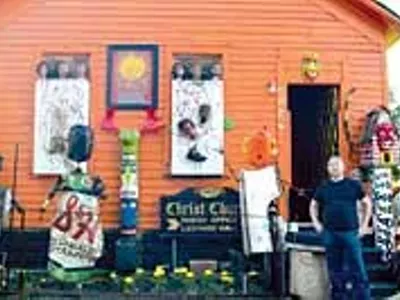The vessel, the figure and architecture — contemporary artists collapse boundaries between these ceramic traditions. For instance, a vessel is a metaphor for the carnal body or an interior architectural space. A kiln can also be a metaphor for architecture, vessel and interior body. At Christopher Gustin's Massachusetts studio, five artist-friends join in a labor-intensive firing process at an anagama, a walk-in multi-chambered brick kiln invented in fifth century Korea and perfected in 16th century Japan. Their practice seeks meaning in the blurred boundaries of function.
The anagama wood-firing process involves two days of loading, six days of continuous team-stoking, and a week of cooling. The many variables of anagama firing — pot placement during loading, flame direction, type of wood fuel and clay, length of firing time, temperature, maturation rate, reduction time and oxidation — all leave an element of chance. The group determines a strategy to achieve the aesthetic results sought by each artist. State-of-the-art kilns can be managed from the Internet today, but these artists prefer to be hands-on because the variables add to the results. Fired together, their art shares a family resemblance due to the characteristics of the specific anagama kiln, yet retains the aesthetic quirks of every individual.
James Lawton appears to be least concerned with traditional function or aesthetics, although his snake-like attenuated forms do function as teapots and flasks, holding liquid in their serpentine chambers. While the scale is intimate, it is possible to imagine moving around the interior spaces as if in a Gaudí architectural fantasy. He also presents a more conventional format: an oval platter with various-sized holes in a purplish matte glaze that look like shaved patches of skin.
Conversely, Todd Wahlstrom's olive oil vessels have both the appearance and reality of function. They can be taken as exotic teapots, but their small removable tops give them away. Delicate and refined, they seduce with muted drippy glazes that meet exposed clay fluted sides. Another gem is his large lidded vessel, where rounded squares in the surface exploit the glaze drip in recesses of pattern, moving from light beige and caramel at the top to slate gray at the base.
With more than 20 cups on floating shelves at eye-level, one can appreciate the great variants of glaze, color and surface Bruce Dehnert has pulled from the fire. But it is frustrating to not be able to see the interior — a frequent and elemental perspective of a cup — as that view is thwarted by the installation. With sophisticated color transitions and sculptural gestures, Chris Gustin's large dimpled coffee cups consider the concept of a cup as much as function, while his large work has crossed over into a place that's just about looking, not using. Two tall vessels shown together can be seen as male and female reflections, containing elements of each other. The voluptuous forms fall into cleavage and hips, the balance between voluptuous and bloated held in perfect tension.
Aysha Peltz's vessels also refer to the body, but more the interior forms. A number of pieces could have been abstracted from the human heart, the tubed spouts squeezing together for the flow between ventricles, but they are also reminiscent of Moche pottery spouts. One of her most beautiful gestures is the way the animated legs lift the piece off the ground plane.
The tired art vs. craft debate often spins around whether art is strictly for contemplation and loses meaning if it serves a pragmatic function. One can look to the Unicorn Tapestries; filled with symbol and meaning, they also stopped drafts in the castle. Should it matter that function became road kill on the way to modernism?
These artists interpret forces at play in contemporary life and seek visual metaphors for those tensions in an ancient process. In a release of the quotidian, they redefine the usefulness that can so easily be linked to drudgery. Lawton could be speaking for all when he says: "Modernism defined use and meaning as separate and mutually unjustified, and it is this disparity which makes the potters' work at this juncture in history most compelling to me."
Chris Gustin and Friends runs through July 15 at Pewabic Pottery, 10125 E. Jefferson Ave., Detroit; 313-822-0954.
Gerry Craig writes about art locally and nationally. Send comments to [email protected]





